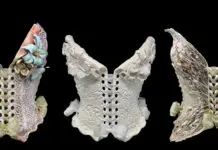Just off a stretch of the Mother Road in northeastern Oklahoma, about halfway between Claremore and Chelsea, lies a town called Foyil. Although its population is tiny, hovering around 250 at last count, Foyil has produced two nationally famous sports stars.
There’s Josh Brown, currently one of the top kickers in the National Football League, whose name is emblazoned on highway signs at either end of Foyil’s city limits, as well as on an activity center at the south end of town. And there’s Andy Payne, whose statue is the centerpiece of a park right beside Route 66.
What’s intriguing about these two isn’t just that they’re both from the same little Oklahoma town. It’s also the fact that both of them became known for their legs: Brown from his past decade in the NFL, Payne because of his winning performance in the Transcontinental Footrace of 1928, an event which, at the time, captivated the entire country.
“Back then, he was probably as famous as Michael Jordan,” says Gerry Payne, Andy’s nephew and a retired county commissioner who lives in Foyil.
“He said that when people found out the runners were coming through, they’d go camp by the highway, drag in a tent or whatever, have a picnic, and watch ‘em go by. He said there were people all along the road.”
“I knew a little bit about Andy from the older folks around town, telling what he did, racing across the country and down 66, ” Brown adds. “There was the story that he’d always run to school, five or six miles, and that’s how he got good, running those long distances.”
In fact, notes Payne, young Andy ran just about everywhere.
“Back then, all they had was a wagon and a team, or a horse, and if they were going to Claremore, Andy would just jog alongside the wagon. And when they went to school, he’d grab hold of the tail of the horse that his sisters or brothers were riding and just run along with ‘em,” he recounts.
The Transcontinental Footrace, backed by the U.S. 66 Highway Association, took place in 1928, under the auspices of a hustling promoter named Charles C. Pyle. Twenty-four hundred of the race’s 3,400 miles went up Route 66, which had been commissioned only a couple of years earlier. With a starting line in Los Angeles and a finish at New York’s Madison Square Garden, the event, nicknamed the Bunion Derby, attracted nearly 300 participants from all across the country; a $25,000 purse was promised to the winner. There were also opportunities for the runners to meet the folks who greeted them in towns along the way, and perhaps to sell a few autographed programs.
“Old Pyle would go ahead of the runners and find the towns that would make him the best deal, and that’s where they’d stop for the night,” Payne notes. “Out in Arizona one day, where there wasn’t any population, they had to run 70 miles before they could quit. Andy said the least he had to run was 15 miles in a day, and the most he had to run was that 70.”
Jogging across chilly mountains and down into arid deserts, through rainstorms, winds and heat, Payne battled through a number of challenges, including a serious throat infection that nearly took him out of the race. But he persevered, emerging – after 573 hours, four minutes, and 34 seconds – the winner. Although he only got $18,000 of the promised $25,000, he used that money to buy land and to get a law degree. Afterwards, he became Clerk of the Oklahoma Supreme Court, a position he held for decades.
Payne died in 1977. The park and statue came along in the early ‘90s, through the efforts of the Foyil Heritage Association, the Rogers County Historical Society and private donations.
It was also a grassroots fund drive, spearheaded by Foyil resident Carrie Rizley, which paid for the Josh Brown signs on Route 66. The Josh Brown Activity Center, Brown explains, was the work of Rev. Richard Hubbard, pastor of Foyil’s House of Prayer Church, which counts Brown’s parents among its members.
“It’s a gym where you can shoot hoops, and they have church activities there,” he explains. “They’re able to give the kids something to do. They’ve got workout equipment, pool tables, and we bought them a nice kitchen so they can put on big dinners and fish fries.
“When Pastor Hubbard called and said, ‘We’d like to name it after you,’ I was like, ‘Well, you sure don’t have to do that, but I appreciate it,’” he adds. “He said, ‘It’s just to let people see how proud we are of you, and to let these kids around here know they can make something of themselves.’
“It was a great honor that they wanted to do it for me, and that’s the message: You can make something of yourself regardless of where you come from.”
Brown himself came from the Foyil Panthers, at the time an eight-man football team, where he played safety and running back and returned kickoffs and punts as well as doing all the team’s kicking. Increasingly, however, he realized that the latter skill was going to be his ticket to a college scholarship – especially after he’d booted an incredible 61-yard field goal in the 1996 state championships. Invited to camp by the University of Nebraska after his junior year, he impressed head coach Tom Osborne enough to land a scholarship.
Still, it wasn’t until Brown’s junior year of college that he began to seriously consider a career in the NFL.
“I played sports because I loved ‘em,” he says. “I loved the competition, I enjoyed the accolades, and I enjoyed all the fun stuff that came along with it. To me it was all just a very large game – the high school life, built on being a football guy and having lots of friends and this and that. It was never really about attaining a goal at that point, except for winning the state championship.”
When he did start thinking about going pro, he adds, “I was talking about it to somebody – without mentioning a name – and he said, ‘You’re not that good. You’re not going to be able to make it. You don’t have good numbers.’
“And at that point, everything else went to the back of the room. Football came first. I finished my degree and I worked and worked.
My numbers went up. I got hold of the correct coaches and the correct trainers outside the university. At that point, I was on a mission.”
Drafted in 2001 by the Seattle Seahawks, Brown hasn’t looked back since. Like Andy Payne before him, he’s a national sports figure with signs in his hometown to prove it. And he shares with Payne the drive, and the dream, it took to break into the national consciousness.
“I’m very proud of being able to come from such a small area and kind of do something big,” says Brown, who now plays for the St. Louis Rams. “There are only 32 people in the world that have this (NFL placekicker) job, and I’m one of ‘em. I’m proud to be a good example for those kids, to let them know they can follow their dreams. You’ve just got to step out, and that can be a hard thing when you live in such a small town.
“Opportunities are not always there. But sometimes we just have to just take a risk and step out on faith and work hard. I mean, that’s really all you can do.”

























